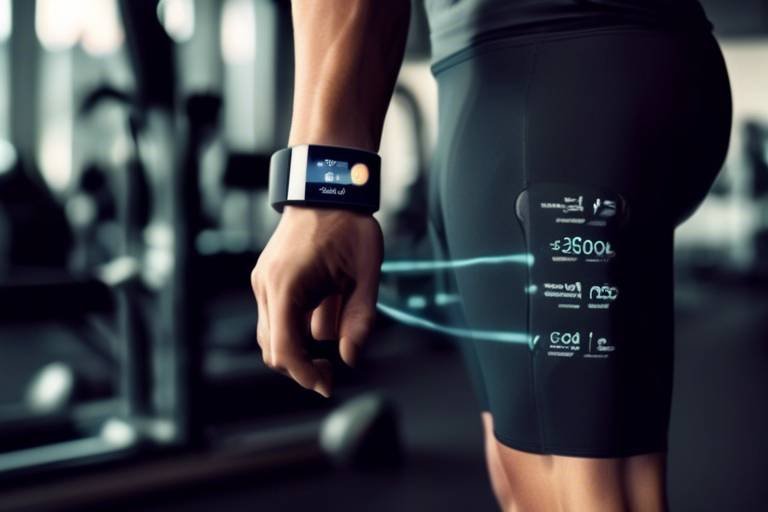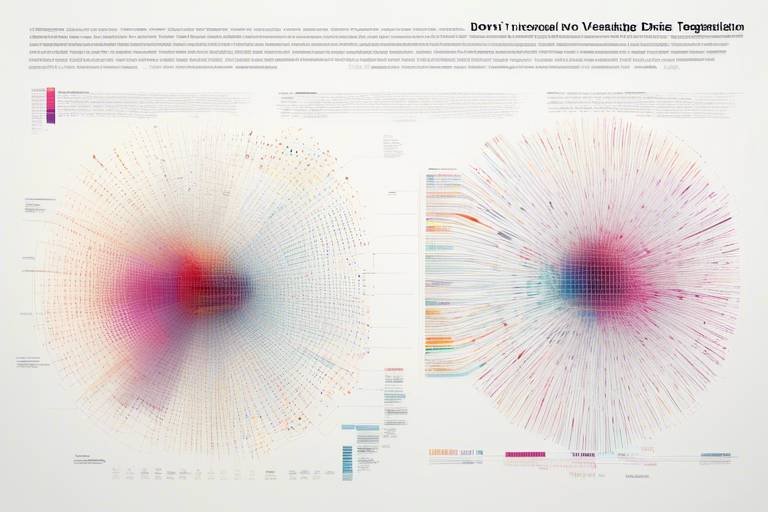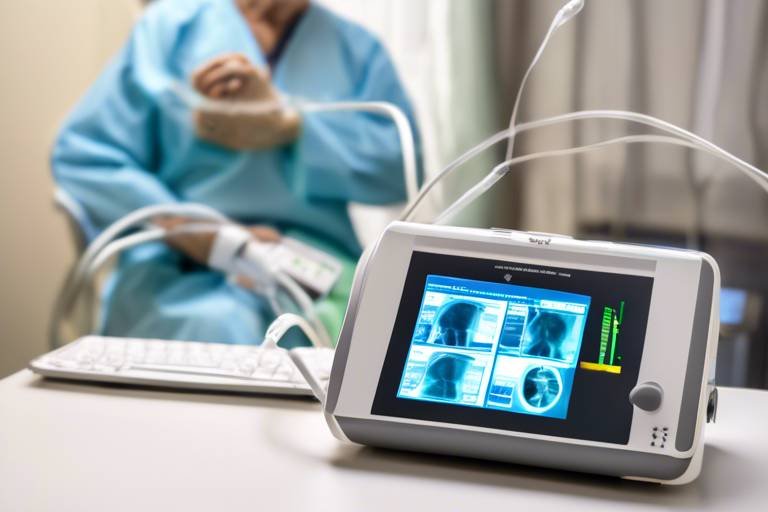Innovations in Disaster Recovery Technologies
In a world where natural disasters and unforeseen emergencies can strike at any moment, the significance of robust disaster recovery technologies cannot be overstated. As we delve into the realm of innovative solutions that are reshaping how we respond to crises, it’s crucial to recognize that these advancements are not just about recovery; they are about building resilience. Imagine a world where businesses can bounce back from disasters almost seamlessly, where communities can swiftly recover and rebuild, and where technology acts as a safety net during the most challenging times. This article explores the cutting-edge advancements in disaster recovery technologies, emphasizing their importance in enhancing resilience and response capabilities during emergencies. From cloud-based solutions to artificial intelligence and mobile technologies, we will uncover the innovations that are transforming recovery efforts across the globe.
Cloud computing has revolutionized disaster recovery by enabling businesses to store data securely off-site, ensuring quick access and restoration in emergencies. With the ability to store vast amounts of data in the cloud, organizations can protect their critical information from physical damage caused by disasters. One of the key features of cloud-based recovery systems is their scalability; businesses can easily adjust their storage needs based on fluctuating demands. Additionally, cloud solutions often come with automated backup processes, reducing the risk of human error. The benefits are clear:
- Accessibility: Data can be accessed from anywhere, at any time, which is crucial during a disaster.
- Cost-Effectiveness: Organizations can save on infrastructure costs by utilizing cloud services instead of maintaining physical servers.
- Rapid Recovery: In the event of a disaster, recovery times can be significantly reduced, allowing businesses to resume operations swiftly.
Overall, cloud-based solutions are not just a trend; they are a fundamental shift in how we approach disaster recovery.
Artificial intelligence (AI) plays a crucial role in disaster recovery by predicting risks and optimizing response strategies. Imagine having a virtual assistant that can analyze vast datasets and provide actionable insights in real-time. This is the power of AI in the context of disaster management. By leveraging machine learning algorithms, organizations can enhance their decision-making processes and allocate resources more effectively during crises. AI technologies are enhancing not only the speed but also the accuracy of recovery efforts, allowing responders to focus on what truly matters—saving lives and restoring communities.
Predictive analytics uses historical data to forecast potential disasters and their impacts. By analyzing patterns and trends, organizations can better prepare for the worst. For example, if a region has a history of flooding during certain months, predictive analytics can alert authorities to take necessary precautions ahead of time. This proactive approach is invaluable in disaster preparedness and recovery planning, helping organizations mitigate risks effectively.
Leveraging data-driven insights allows organizations to make informed decisions during recovery efforts. By utilizing analytics, companies can identify which resources are needed most urgently and allocate them accordingly. This segment highlights the importance of analytics in shaping recovery strategies and improving outcomes. The ability to make decisions based on solid data rather than intuition can mean the difference between a successful recovery and a prolonged struggle.
Real-time monitoring systems provide critical information during disasters, enabling quick responses. Technologies such as drones and IoT devices facilitate continuous surveillance and data collection, which is essential for effective recovery management. Imagine being able to monitor the status of infrastructure or the movement of people in real-time; this information can guide rescue operations and resource distribution, ultimately saving lives.
Automation streamlines recovery efforts by reducing manual tasks and enhancing efficiency. Various automated solutions, such as chatbots for customer service and automated alert systems, can accelerate recovery timelines and improve overall effectiveness. For instance, instead of manually contacting thousands of customers, an automated system can send out alerts and updates in a fraction of the time. This not only frees up human resources but also ensures that critical information reaches those who need it most without delay.
Mobile technology has become essential in disaster recovery, offering communication and coordination tools during emergencies. The rise of smartphones has paved the way for innovative mobile applications and platforms that support disaster response efforts. These tools are not just convenient; they are lifelines during crises. For example, mobile apps can provide real-time updates on evacuation routes, shelter locations, and safety tips. The accessibility of information at the fingertips of responders and affected individuals can significantly enhance the effectiveness of recovery efforts.
Emergency communication apps facilitate real-time information sharing among responders and affected individuals. These applications are designed to enhance situational awareness during disasters by providing users with up-to-date information on the unfolding situation. Features such as push notifications, location tracking, and group messaging can significantly improve coordination among various stakeholders involved in disaster response.
Geolocation services play a vital role in disaster recovery by providing accurate location data for affected areas. By utilizing GPS technology, rescue teams can pinpoint the locations of individuals in need of assistance, ensuring that resources are allocated where they are most needed. This capability is crucial for effective recovery planning and resource distribution, ultimately leading to a more organized and efficient response.
Q1: What are the key benefits of cloud-based disaster recovery solutions?
A1: Cloud-based solutions offer scalability, cost-effectiveness, and rapid recovery times, making them essential for businesses looking to safeguard their data during emergencies.
Q2: How does AI enhance disaster recovery efforts?
A2: AI enhances disaster recovery by predicting risks, optimizing resource allocation, and providing data-driven insights that improve decision-making during crises.
Q3: What role do mobile technologies play in disaster response?
A3: Mobile technologies provide essential communication and coordination tools, allowing responders and affected individuals to share real-time information and updates during emergencies.

Cloud-Based Solutions
In today's fast-paced world, cloud computing has emerged as a game-changer in the realm of disaster recovery. Imagine being able to access your critical data from anywhere, at any time, without the fear of losing it to unforeseen disasters. This is precisely what cloud-based solutions offer—an innovative way to safeguard your information while ensuring swift recovery when emergencies strike. By storing data securely off-site, businesses can significantly enhance their resilience and response capabilities during crises.
One of the standout features of cloud-based recovery systems is their scalability. Organizations can easily adjust their storage capacity based on their current needs, which means they only pay for what they use. This flexibility is crucial for businesses that experience fluctuations in data volume. For instance, a company may require more storage during peak seasons, but less during quieter times. With cloud solutions, they can scale their resources effortlessly, optimizing costs while maintaining data integrity.
Additionally, cloud solutions enable rapid data restoration. In the event of a disaster, time is of the essence. The faster an organization can recover its data, the quicker it can resume operations. Cloud-based systems are designed for quick access and restore capabilities, allowing businesses to minimize downtime. This is particularly important for industries where every second counts, such as healthcare and finance. Imagine a hospital being able to retrieve patient records within minutes—this could mean the difference between life and death.
Another significant advantage of cloud-based disaster recovery is the redundancy it provides. By storing data across multiple locations, cloud providers ensure that even if one data center goes down, the information remains safe and accessible from another site. This multi-location strategy not only enhances data security but also provides peace of mind to organizations, knowing that their critical information is protected against localized disasters.
Moreover, cloud solutions come equipped with advanced security measures that are often beyond the reach of traditional on-premises systems. With features like encryption, access controls, and regular security audits, cloud providers invest heavily in protecting their clients' data. This level of security is essential, especially when dealing with sensitive information such as personal identification or financial records.
To illustrate the benefits of cloud-based solutions, consider the following table that summarizes key features and their impacts on disaster recovery:
| Feature | Impact on Disaster Recovery |
|---|---|
| Scalability | Adjust resources as needed; cost-effective |
| Rapid Data Restoration | Minimizes downtime; quick access to critical data |
| Redundancy | Data remains safe across multiple locations |
| Advanced Security | Protects sensitive information with robust measures |
In conclusion, cloud-based solutions are not just a trend; they are a vital component of modern disaster recovery strategies. By leveraging the power of the cloud, organizations can enhance their resilience, streamline recovery processes, and ensure that they are well-prepared for any unforeseen events. As we continue to innovate and adapt to new challenges, embracing these technologies will be crucial for businesses aiming to thrive in an unpredictable world.
- What is cloud-based disaster recovery? Cloud-based disaster recovery refers to the use of cloud computing resources and services to protect and restore data after a disaster.
- How does cloud-based recovery differ from traditional methods? Unlike traditional recovery methods that rely on physical backups, cloud-based solutions offer off-site storage, rapid access, and enhanced security.
- What industries benefit the most from cloud-based disaster recovery? Industries such as healthcare, finance, and e-commerce benefit significantly due to their need for quick data access and high security.
- Is cloud-based recovery cost-effective? Yes, cloud solutions are typically more cost-effective as they allow businesses to scale resources based on their needs, reducing unnecessary expenses.

Artificial Intelligence in Recovery
Artificial Intelligence (AI) is not just a buzzword; it's a game-changer in the realm of disaster recovery. Imagine having a smart assistant that can analyze vast amounts of data in seconds, predicting potential crises before they even happen. This is the power of AI. By harnessing sophisticated algorithms, AI systems can identify patterns in historical data, enabling organizations to anticipate disasters and devise effective response strategies. It's like having a crystal ball that helps organizations prepare for the unexpected.
One of the most exciting applications of AI in disaster recovery is its ability to enhance decision-making processes. During a crisis, time is of the essence. AI can analyze real-time data from various sources—social media, weather reports, and emergency services—to provide actionable insights. This allows decision-makers to allocate resources efficiently and prioritize areas that need immediate attention. Think of it as having a highly trained team of analysts working around the clock to ensure that every decision is data-driven and timely.
Predictive analytics is a cornerstone of AI's role in disaster recovery. By utilizing historical data, AI tools can forecast potential disasters and their impacts. For instance, if a region has experienced flooding in the past, predictive analytics can estimate the likelihood of future floods based on weather patterns and soil saturation levels. This proactive approach allows organizations to implement preventive measures, such as reinforcing infrastructure or conducting community awareness programs. Essentially, predictive analytics transforms reactive strategies into proactive planning, saving lives and resources.
Data-driven decision-making is crucial in recovery efforts. With AI at the helm, organizations can leverage data insights to shape their recovery strategies. For example, after a disaster strikes, AI can analyze the effectiveness of response efforts in real-time and suggest adjustments based on what is working or failing. This dynamic feedback loop ensures that recovery plans are not static but evolve based on current conditions and outcomes. By integrating AI into their operations, organizations can significantly improve their recovery outcomes, making every decision count.
Real-time monitoring systems are vital during disasters, providing critical information that can make or break recovery efforts. AI technologies facilitate continuous surveillance and data collection, allowing emergency responders to track evolving situations. For instance, drones equipped with AI can survey affected areas, assessing damage and identifying safe routes for rescue operations. This real-time data is invaluable, enabling quick responses and ensuring that help reaches those in need as swiftly as possible. It's like having an eagle eye in the sky, constantly watching over the affected regions.
Automation is another aspect where AI shines in disaster recovery. By automating routine tasks, organizations can streamline their recovery efforts, reducing the burden on human resources. For example, automated systems can manage logistics, such as tracking supplies and coordinating transportation, freeing up personnel to focus on more complex tasks. This not only enhances efficiency but also accelerates recovery timelines. Imagine a well-oiled machine operating seamlessly, ensuring that every part of the recovery process is functioning optimally.
In summary, the integration of AI in disaster recovery is revolutionizing how organizations prepare for and respond to emergencies. From predictive analytics and data-driven decision-making to real-time monitoring and automation, AI empowers responders to act swiftly and effectively. As we continue to face the challenges posed by natural disasters, embracing these innovations is not just advantageous; it's essential for building a resilient future.
- What is the role of AI in disaster recovery? AI enhances decision-making, predicts potential disasters, and automates recovery processes, making response efforts more efficient.
- How does predictive analytics contribute to disaster preparedness? It analyzes historical data to forecast future disasters, allowing organizations to implement proactive measures.
- Can AI improve real-time monitoring during disasters? Yes, AI technologies facilitate continuous data collection and surveillance, enabling quick responses to evolving situations.
- What are the benefits of automation in recovery processes? Automation streamlines operations, reduces manual tasks, and accelerates recovery timelines, improving overall effectiveness.

Predictive Analytics
In the realm of disaster recovery, has emerged as a game-changer, allowing organizations to foresee potential disasters before they strike. Imagine having a crystal ball that can analyze past events and forecast future risks—this is precisely what predictive analytics offers. By utilizing vast amounts of historical data, organizations can identify patterns and trends that indicate the likelihood of various disasters, from natural calamities like hurricanes and earthquakes to man-made crises such as industrial accidents.
One of the key advantages of predictive analytics is its ability to enhance disaster preparedness. For instance, organizations can utilize predictive models to assess the vulnerability of their infrastructure and resources. By analyzing factors such as geographical location, weather patterns, and historical incident reports, businesses can develop comprehensive recovery plans tailored to their specific risks. This proactive approach not only saves time and resources but also significantly reduces the impact of disasters when they occur.
Moreover, predictive analytics can be instrumental in resource allocation during recovery efforts. By understanding which areas are most likely to be affected, organizations can pre-position resources and personnel, ensuring a swift response when disaster strikes. This strategic planning is akin to a chess game, where anticipating your opponent's moves can lead to victory. Similarly, by anticipating disaster scenarios, organizations can mitigate damage and enhance recovery outcomes.
To illustrate the power of predictive analytics, let’s take a look at a hypothetical scenario:
| Scenario | Predicted Event | Recommended Action |
|---|---|---|
| Severe Weather Alerts | High likelihood of flooding | Pre-deploy emergency response teams and resources to vulnerable areas |
| Historical Earthquake Data | Increased seismic activity | Conduct structural assessments and reinforce buildings |
| Wildfire Season | High temperatures and dry conditions | Implement controlled burns and prepare firefighting resources |
As shown in the table, predictive analytics not only identifies potential disasters but also guides organizations on the appropriate actions to take. This data-driven decision-making process is crucial in shaping effective recovery strategies, ultimately leading to better outcomes for communities and businesses alike.
In conclusion, the integration of predictive analytics into disaster recovery planning is more than just a technological advancement; it represents a fundamental shift in how we approach risk management. By leveraging data to predict future events, organizations can enhance their resilience, ensuring they are not just reacting to disasters, but actively preparing for them. This proactive mindset can make all the difference in saving lives and minimizing damage when the unexpected occurs.
- What is predictive analytics? Predictive analytics involves using historical data and statistical algorithms to forecast future events, particularly in the context of disaster management.
- How does predictive analytics improve disaster recovery? By anticipating potential disasters and their impacts, organizations can prepare more effectively, allocate resources efficiently, and ultimately reduce the damage caused by such events.
- Can predictive analytics be applied to all types of disasters? Yes, predictive analytics can be utilized for various types of disasters, including natural disasters, technological failures, and public health emergencies.

Data-Driven Decision Making
In the chaotic aftermath of a disaster, every second counts. Decisions made in these critical moments can mean the difference between life and death, or between swift recovery and prolonged hardship. This is where comes into play, acting as a lighthouse guiding organizations through the fog of uncertainty. By harnessing the power of data analytics, organizations can make informed choices that significantly enhance their recovery strategies.
Imagine trying to navigate a ship through a storm without a map or compass. That’s what disaster recovery looks like without data. With data-driven insights, organizations can analyze patterns, understand past incidents, and predict future risks. This approach allows them to allocate resources more effectively, identify vulnerable areas, and prioritize actions that will have the most significant impact. For instance, data can reveal which communities are most at risk of flooding or which infrastructure is most likely to fail during an earthquake, enabling preemptive measures that save lives and resources.
Moreover, the integration of data analytics into recovery planning helps organizations to evaluate the effectiveness of their strategies in real-time. This means that if a particular approach isn’t yielding the desired results, adjustments can be made swiftly. The ability to pivot based on data not only improves the recovery process but also fosters a culture of continuous improvement. Organizations that embrace this mindset are better equipped to handle future disasters, as they learn from each experience and refine their strategies accordingly.
To illustrate the impact of data-driven decision making, consider the following table that outlines key benefits:
| Benefit | Description |
|---|---|
| Enhanced Resource Allocation | Data analytics helps in identifying high-risk areas, ensuring that resources are directed where they are needed the most. |
| Improved Risk Assessment | Analyzing historical data allows organizations to better understand potential risks and prepare accordingly. |
| Informed Strategy Development | Data-driven insights guide the development of effective recovery strategies tailored to specific scenarios. |
| Real-Time Adjustments | Organizations can make quick adjustments to their strategies based on real-time data, enhancing overall effectiveness. |
In conclusion, data-driven decision making is not just a trend; it's a necessity for effective disaster recovery. By leveraging analytics, organizations can transform chaos into clarity, ensuring that their recovery efforts are as efficient and impactful as possible. As we continue to innovate in this space, the importance of data will only grow, making it an essential tool for those looking to enhance their resilience in the face of disaster.
- What is data-driven decision making? Data-driven decision making involves using data analytics to guide choices and strategies, particularly in critical situations like disaster recovery.
- How can data improve disaster recovery? By providing insights into risks and resource allocation, data helps organizations make informed, timely decisions that enhance recovery efforts.
- What tools are used for data-driven decision making? Various analytics tools and software platforms are available to help organizations analyze data and derive actionable insights.
- Can small organizations utilize data-driven decision making? Absolutely! With the right tools and resources, even small organizations can leverage data to improve their disaster recovery strategies.

Real-Time Monitoring
In today’s fast-paced world, has emerged as a game-changer in disaster recovery efforts. Imagine being able to keep your finger on the pulse of a crisis as it unfolds—this is precisely what real-time monitoring offers. By employing advanced technologies, organizations can gather and analyze data instantly, allowing for timely interventions and effective resource allocation. This capability is not just a luxury; it’s a necessity that can make the difference between chaos and control during emergencies.
One of the key components of real-time monitoring is the integration of Internet of Things (IoT) devices. These smart devices collect data from various sources, such as weather sensors, surveillance cameras, and even social media feeds. For instance, when a natural disaster strikes, IoT sensors can provide critical information about environmental changes, such as rising water levels or seismic activity. This data becomes invaluable for emergency responders, who can use it to assess the situation and deploy resources where they are needed most.
Another vital aspect of real-time monitoring is the use of geospatial technologies. Geographic Information Systems (GIS) enable responders to visualize data on maps, making it easier to identify affected areas and plan recovery efforts. For example, during a flood, GIS can show which neighborhoods are submerged, allowing for targeted rescue operations. The visual representation of data helps in understanding the scope of the disaster and facilitates better communication among all stakeholders involved.
Moreover, real-time monitoring systems often come equipped with alert mechanisms that notify relevant parties about critical developments. These alerts can be sent via text messages, emails, or push notifications, ensuring that everyone—from government agencies to local communities—stays informed. This immediate dissemination of information is crucial for coordinating rescue operations and ensuring that no one is left behind.
To illustrate the impact of real-time monitoring, consider the following table that summarizes its benefits:
| Benefit | Description |
|---|---|
| Timely Data Collection | Gathering data instantly to inform decision-making. |
| Enhanced Situational Awareness | Providing a clear picture of the disaster's impact. |
| Improved Resource Allocation | Ensuring that resources are deployed where they are needed most. |
| Effective Communication | Facilitating information sharing among responders and the public. |
In conclusion, real-time monitoring is not just about keeping track of events; it's about transforming how we respond to disasters. With the right tools and technologies, organizations can enhance their resilience and improve recovery outcomes. As we continue to face increasingly complex challenges in disaster management, investing in real-time monitoring solutions will undoubtedly pay off in the long run.
- What is real-time monitoring?
Real-time monitoring refers to the continuous observation and analysis of data as events unfold, allowing for immediate responses during emergencies. - How do IoT devices contribute to disaster recovery?
IoT devices collect real-time data from various sources, providing critical insights that help organizations respond effectively to disasters. - What role does GIS play in disaster recovery?
GIS helps visualize data on maps, facilitating better understanding and planning for recovery efforts. - Why is timely data collection important?
Timely data collection allows for informed decision-making, which is crucial in managing disaster response effectively.

Automation in Recovery Processes
In the realm of disaster recovery, automation has emerged as a game-changer, fundamentally transforming how organizations respond to emergencies. Imagine a world where recovery processes are not only faster but also more accurate, reducing the chaos that often accompanies disasters. With automation, this vision is becoming a reality. By minimizing human intervention in routine tasks, automated systems free up valuable time and resources, allowing teams to focus on more critical aspects of recovery.
One of the primary advantages of automation in recovery processes is its ability to enhance efficiency. For instance, automated data backups ensure that crucial information is regularly saved without the need for manual input. This means that in the event of a disaster, organizations can swiftly restore their data and systems, significantly reducing downtime. Furthermore, automation tools can manage and execute recovery plans with precision, ensuring that every step is followed meticulously. This is akin to having a well-oiled machine where each part works in harmony to achieve a common goal.
Moreover, automation facilitates real-time updates and monitoring. During a disaster, time is of the essence, and having instant access to information can make all the difference. Automated systems can provide continuous updates on the status of recovery efforts, allowing decision-makers to adapt their strategies as needed. For example, if a particular resource is running low, automated alerts can notify the relevant personnel immediately, prompting quicker action. This capability not only streamlines the recovery process but also enhances overall situational awareness.
Consider the following table that illustrates some key automated solutions in disaster recovery:
| Automated Solution | Description | Benefits |
|---|---|---|
| Automated Backup Systems | Regularly scheduled backups of critical data without manual intervention. | Minimizes data loss, saves time during recovery. |
| Disaster Recovery Orchestration | Automated execution of recovery plans across different systems. | Ensures consistency, reduces human error. |
| Incident Response Tools | Automated alerts and notifications during emergencies. | Enhances communication, speeds up response time. |
Additionally, automation can significantly improve resource allocation. During a disaster, knowing where to direct resources can be challenging. Automated systems can analyze data from various sources and recommend the most effective allocation of resources based on real-time needs. This data-driven approach ensures that help reaches those who need it the most, when they need it, ultimately saving lives and reducing suffering.
In conclusion, the integration of automation into disaster recovery processes is not just a trend; it is a necessity in our increasingly complex world. As organizations continue to embrace these technologies, they will not only enhance their recovery capabilities but also build a more resilient framework capable of withstanding future challenges. The future of disaster recovery is here, and it is automated!
- What is automation in disaster recovery? Automation in disaster recovery refers to the use of technology to perform recovery tasks without human intervention, enhancing efficiency and accuracy.
- How does automation improve recovery times? Automated systems can execute recovery plans and restore data much faster than manual processes, significantly reducing downtime.
- Are there any risks associated with automation in recovery? While automation brings many benefits, it is essential to ensure that systems are regularly tested and updated to prevent potential failures during actual disasters.
- Can small businesses benefit from automated recovery solutions? Absolutely! Many automated recovery tools are scalable and can be tailored to fit the needs of small businesses, making them more resilient against disasters.

Mobile Technologies for Disaster Response
In today's fast-paced world, mobile technologies have emerged as a lifeline during disasters, providing essential tools for communication and coordination. Imagine being in the midst of a natural disaster—whether it's a hurricane, earthquake, or flood—where every second counts. Mobile devices become more than just gadgets; they transform into critical instruments that can save lives and streamline recovery efforts. With the power of smartphones and apps, responders can communicate instantly, share vital information, and coordinate their actions more effectively than ever before.
One of the standout features of mobile technology in disaster response is the development of emergency communication apps. These applications are designed to facilitate real-time information sharing among responders, government agencies, and affected individuals. For instance, apps like Everbridge and FEMA provide users with alerts, updates, and safety instructions, ensuring that everyone is informed and can take appropriate action. The ability to send push notifications directly to users' phones means that critical information reaches them without delay, which can be the difference between safety and danger.
Moreover, these apps often include features such as interactive maps that show evacuation routes, shelters, and safe zones. This functionality not only helps individuals navigate through chaos but also allows emergency services to track the movement of people and resources. Imagine trying to find your way to safety during a storm; having a map that updates in real-time can provide a sense of direction and calm amidst the turmoil.
Another essential aspect of mobile technologies in disaster response is the use of geolocation services. These services provide accurate location data for affected areas, which is crucial for effective resource allocation and recovery planning. For example, during a flood, responders can use geolocation to identify regions that are most affected and prioritize their efforts accordingly. This technology ensures that aid reaches those who need it most, minimizing the time it takes to deliver help.
In addition to these apps and services, mobile technologies also enable crowdsourcing of information. Citizens can report incidents, share photos, and provide updates on conditions in their areas, creating a real-time picture of the disaster landscape. This grassroots data can be invaluable for emergency management teams, helping them to understand the situation on the ground better and make informed decisions.
To illustrate the impact of mobile technologies on disaster response, consider the following table that outlines key applications and their features:
| Application | Key Features | Impact on Response |
|---|---|---|
| Everbridge | Real-time alerts, two-way communication | Enhances situational awareness |
| FEMA App | Emergency kit checklist, disaster resources | Informs the public about safety measures |
| Waze | Traffic updates, road closures | Facilitates efficient routing for emergency vehicles |
In conclusion, mobile technologies are not just a convenience; they are essential tools that enhance disaster response capabilities. By facilitating communication, providing real-time information, and enabling effective resource allocation, these technologies empower both responders and communities to navigate the challenges posed by disasters more effectively. As we continue to innovate and improve these technologies, we can only hope for a future where disaster response becomes even more efficient and life-saving.
- How do mobile technologies improve disaster response? Mobile technologies enhance communication, provide real-time updates, and facilitate resource allocation during emergencies.
- What are some popular emergency communication apps? Some popular apps include Everbridge, FEMA, and Red Cross Emergency.
- Can crowdsourcing help in disaster recovery? Yes, crowdsourcing allows citizens to report conditions and share information, which can aid emergency management teams in making informed decisions.

Emergency Communication Apps
In the chaotic aftermath of a disaster, communication can be the lifeline that connects responders, victims, and the broader community. Enter emergency communication apps—these digital tools have transformed how we share information during crises. Imagine being in a situation where every second counts; having the right app can mean the difference between chaos and coordinated response.
These applications are designed to facilitate real-time information sharing among emergency responders and affected individuals. They offer features such as push notifications, live updates, and community alerts, ensuring that everyone stays informed. For instance, during a natural disaster, an app can send out alerts about evacuation routes, shelter locations, and safety tips, all tailored to the user’s location.
One of the standout features of these apps is their ability to create a network of communication. This network can be invaluable, especially in areas where traditional communication systems might be down. By utilizing peer-to-peer technology, these apps can allow users to share information directly with one another, bypassing the need for cellular networks that may be overloaded or damaged.
Here are some key functionalities that make emergency communication apps indispensable:
- Real-Time Alerts: Users receive immediate notifications about emergencies, ensuring they are always in the loop.
- Group Messaging: Responders can create groups for better coordination, allowing for quick decision-making and resource allocation.
- Location Sharing: Users can share their locations with emergency services, making it easier for help to arrive.
- Resource Mapping: Many apps provide maps that highlight critical resources like hospitals, shelters, and food distribution points.
Moreover, the effectiveness of these apps extends beyond just immediate communication. They also play a crucial role in post-disaster recovery. By collecting data on where assistance is needed most, these apps can help organizations prioritize their efforts and allocate resources more efficiently. This data-driven approach not only enhances the response during the crisis but also informs future preparedness strategies.
In summary, emergency communication apps are not just tools; they are essential components of modern disaster response strategies. They empower individuals to stay informed and connected, paving the way for a more organized and effective recovery process. As technology continues to evolve, we can expect these apps to become even more sophisticated, integrating features like AI-driven analytics and enhanced geolocation services to further improve their impact during emergencies.

Geolocation Services
In the realm of disaster recovery, have emerged as a game-changer, providing invaluable insights that can make or break a response effort. Imagine a scenario where a natural disaster strikes—a hurricane, an earthquake, or a flood. In such chaotic moments, knowing where to allocate resources, how to reach affected individuals, and understanding the extent of damage can significantly enhance recovery efforts. Geolocation technologies offer real-time data that pinpoint the exact locations of people in need, enabling responders to act swiftly and efficiently.
One of the most significant advantages of geolocation services is their ability to provide accurate location data during emergencies. This information is not just about coordinates on a map; it encompasses a variety of critical elements, including:
- Victim Location: Identifying where individuals are trapped or in distress.
- Resource Tracking: Monitoring the movement of supplies and personnel in real-time.
- Damage Assessment: Understanding which areas are most affected and require immediate attention.
Moreover, these services facilitate better coordination among various agencies and organizations involved in disaster response. When multiple teams can access the same geolocation data, they can collaborate more effectively, reducing the chances of duplicated efforts and ensuring that every affected area receives the attention it deserves. This synergy is crucial, especially in large-scale disasters where the scope of response efforts can be overwhelming.
To illustrate the impact of geolocation services in disaster recovery, consider the following table that outlines their applications:
| Application | Description |
|---|---|
| Search and Rescue Operations | Utilizing GPS data to locate missing persons and guide rescue teams. |
| Resource Distribution | Mapping out areas in need of supplies and directing aid to those locations. |
| Evacuation Planning | Identifying safe routes and shelters for displaced individuals. |
As we navigate through the complexities of disaster recovery, it becomes increasingly clear that geolocation services are not just optional tools; they are essential components of a comprehensive recovery strategy. The ability to access and analyze location-based data in real-time can significantly enhance situational awareness, allowing responders to make informed decisions that save lives and resources.
In conclusion, the integration of geolocation services into disaster response frameworks is a testament to how technology can bridge gaps in communication and coordination. By harnessing the power of these services, we can ensure that our recovery efforts are not only efficient but also effective in reaching those who need help the most.
Q: How do geolocation services enhance disaster recovery efforts?
A: Geolocation services provide real-time data on the locations of affected individuals and resources, enabling more efficient coordination and response during emergencies.
Q: Are geolocation services only useful during natural disasters?
A: No, they can also be utilized in various emergencies, including industrial accidents, terrorist attacks, and public health crises, by helping responders locate individuals and assess situations quickly.
Q: What technologies are used in geolocation services?
A: Common technologies include GPS, GIS (Geographic Information Systems), and mobile applications that leverage location data to provide insights during emergencies.
Frequently Asked Questions
- What are cloud-based disaster recovery solutions?
Cloud-based disaster recovery solutions allow organizations to store their data securely off-site. This means that in the event of a disaster, businesses can quickly access and restore their critical information without the need for physical infrastructure. The beauty of these solutions lies in their scalability, flexibility, and the ability to operate from anywhere, making them a game-changer in emergency scenarios.
- How does artificial intelligence enhance disaster recovery?
Artificial intelligence (AI) enhances disaster recovery by predicting potential risks and optimizing response strategies. By analyzing vast amounts of data, AI can identify patterns and foresee disasters before they occur. This proactive approach allows organizations to allocate resources more efficiently and make informed decisions during crises, ultimately saving lives and minimizing damage.
- What is predictive analytics in disaster recovery?
Predictive analytics involves using historical data to forecast future disasters and their potential impacts. This technique helps organizations prepare better by understanding the likelihood of various scenarios and planning accordingly. By leveraging predictive analytics, businesses can mitigate risks and streamline their recovery efforts, ensuring they are ready for whatever comes their way.
- Why is data-driven decision making important in recovery efforts?
Data-driven decision making is crucial because it allows organizations to base their recovery strategies on solid evidence rather than guesswork. By analyzing data, organizations can identify what works and what doesn’t, leading to more effective recovery plans. In times of crisis, having accurate information at your fingertips can make all the difference in the world.
- What role do mobile technologies play in disaster response?
Mobile technologies are vital during disaster response as they facilitate communication and coordination among responders and affected individuals. Innovative mobile applications enable real-time information sharing, helping everyone stay informed and connected. This technology not only enhances situational awareness but also ensures that resources are allocated effectively to areas in need.
- How do geolocation services assist in disaster recovery?
Geolocation services provide accurate location data for affected areas, which is essential during disaster recovery. By pinpointing where help is needed most, these services enable organizations to allocate resources efficiently and develop targeted recovery plans. This level of precision ensures that aid reaches those who need it the most, speeding up the recovery process.



















